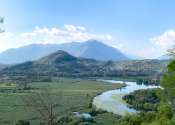Changes in Earth's orbit may have triggered ancient warming event
Changes in Earth's orbit that favored hotter conditions may have helped trigger a rapid global warming event 56 million years ago that is considered an analog for modern climate change, according to an international team ...









